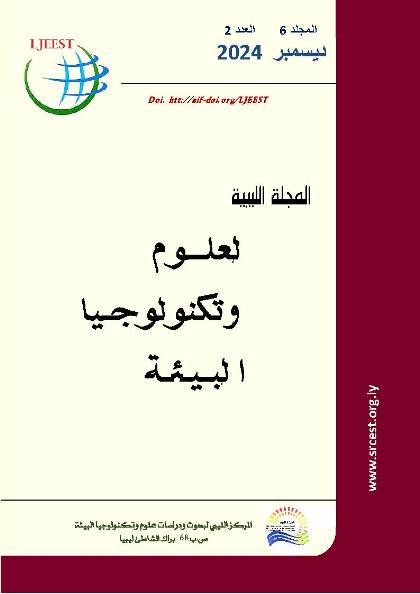حصر الحشرات العاشبة المرتبطة بشجيرتي العرعر والبطوم فى برقة- ليبيا
DOI:
https://doi.org/10.63359/04rdkw24الكلمات المفتاحية:
الجبل الأخضر- برقة، ليبيا، الحشرات العاشبة، العرعر الفينيقي، البطوم الاتلنتيكيالملخص
تم إجراء هذا البحث في منطقة الجبل الأخضر بمنطقة برقة الليبية لدراسة الحشرات العاشبة المصاحبة لنبات العرعر الفينيقي Juniperus phoenicea والبطوم الاتلنتيكي Pistacia atlantica. بعد اختيار التركيز على النوعين الرئيسيين العرعر الفينيقي J. phoenicea والبطوم الاتلنتيكي P. atlantica. من مواقع الدراسة الثلاثة، تم تعيين تسع قطع بالتفصيل وأخذ عينات من الحشرات العاشبة من النباتات المستهدفة فى الدراسة، وثم من جميع النباتات المجاورة للنباتات المستهدفة وتم تحديد مجموعة العواشب الحشرية التي تم جمعها من النباتات الموجودة في القطع التجريبية على الأنواع باستخدام خبرة طاقم متحف التاريخ الطبيعي في لندن. بعض الحشرات تم تسجيلها جديدة أول مرة فى ليبيا ، وهناك عدة أنواع لم يتم تسجيلها من قبل على أنها تتغذى على أي من النوعين النباتيين المدروسين كان النوع (Bostrichidae) Xylomeira sp أكثر الأنواع شيوعًا على العرعر في فى الدراسة، وهو نوع يهاجم الأخشاب الحية والميتة قد يكون هذا من الحشرات العاشبة الهامة التي يمكن أن تؤثر على بقاء وتاريخ حياة العرعر في الجبل الأخضر في الواقع، كانت الخنافس تقريبًا جميع الأنواع الأكثر شيوعًا على العرعر، بما في ذلك العديد من الأنواع الثاقبة للخشب ، مثل Agrilus (Xeragrilus) sp. (Buprestidae) و Purpuricenus desfontainii (Cerambycidae) من الواضح أن العرعر مصدر رئيسي للخنافس في هذه المنطقة من ناحية أخرى ، تباينت الأنواع الأكثر شيوعًا بين مدة الدراسة، مع وجود حشرات من رتبة مستقيمة Orthoptera على رأس القائمة في الدراسة مثل Paracinipe (Acinipe) orientalis و Oedopodacae rulescens و Scintharista notabilis كانت مجموعة من الخنافس الثاقبة للخشب أكثر شيوعًا في العينات ، وبعضها كان مماثلاً لتلك الموجودة على العرعر قد يشير هذا التباين إلى أن جودة البطوم كمضيف تختلف عبر السنين، لكن ليس لدينا في الحقيقة أي مؤشر حقيقي على أساسها من الواضح أن الجغرافيا هي أحد التأثيرات الرئيسية على توزيع الحيوانات العاشبة للحشرات في الجبل الأخضر في النظام البيئي للبحر الأبيض المتوسط. يزداد عدد الأنواع المسجلة بشكل كبير مع الارتفاع فى منطقة الظاهر، في حين أن منطقة الوسيطة لديها أكبر وفرة إجمالية للحشرات. كما زاد ضرر الحشرات بالنباتات مع الارتفاع. في المقابل ، كان النوعان الأكثر شيوعًا لديهما أكبر وفرة في منطقة الظاهر (Xylomeira) وأدنى ارتفاعات منطقة الساحل (Oedopoda). عادة ما وجد أن ضغط الحيوانات العاشبة يكون أعلى في الارتفاعات المنخفضة )منطقة الساحل(. يتأثر تنوع الحشرات العاشبة أيضًا بتركيب النبات ، وحجم وشكل النمو وتنوع منافذ التغذية في النبات. لذلك ، بالنسبة للمنطقة، فإن الأشجار بها أنواع آكلات أعشاب أكثر من الشجيرات، والتي بدورها تحتوي على أكثر من الأعشاب. من المعروف أن العديد من السمات النباتية الأخرى تؤثر على تنوع الحشرات العاشبة، على سبيل المثال ، الكيمياء الحيوية للنبات، والتقارب التصنيفي والثراء المحلي. إذا زاد ضغط الحيوانات العاشبة بالفعل مع الارتفاع في الجبل الأخضر، فقد نتوقع أن مستويات الدفاع قد تعكس ذلك وبالتالي قد نتوقع زيادة مستويات التانين مع الارتفاع.















